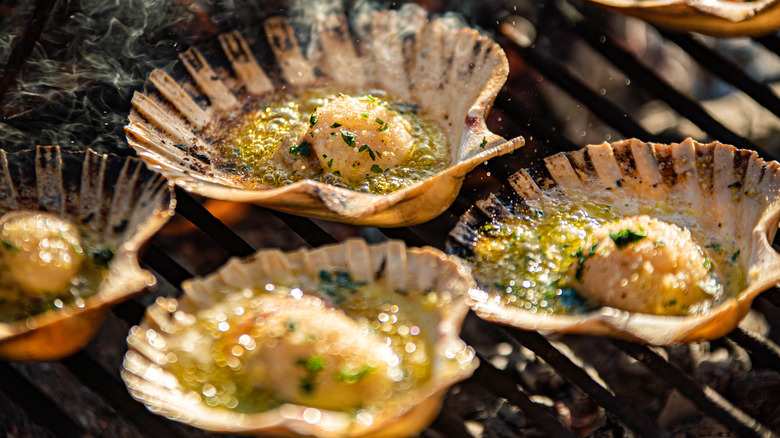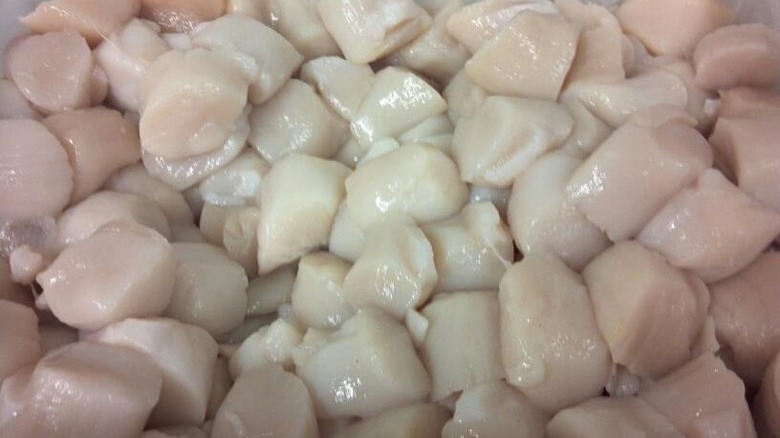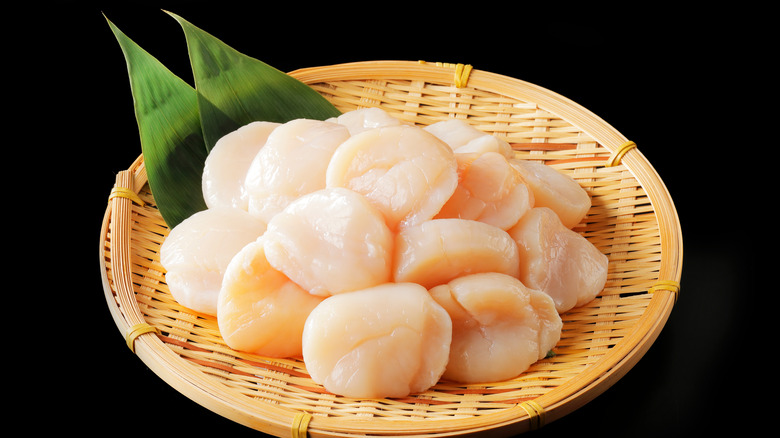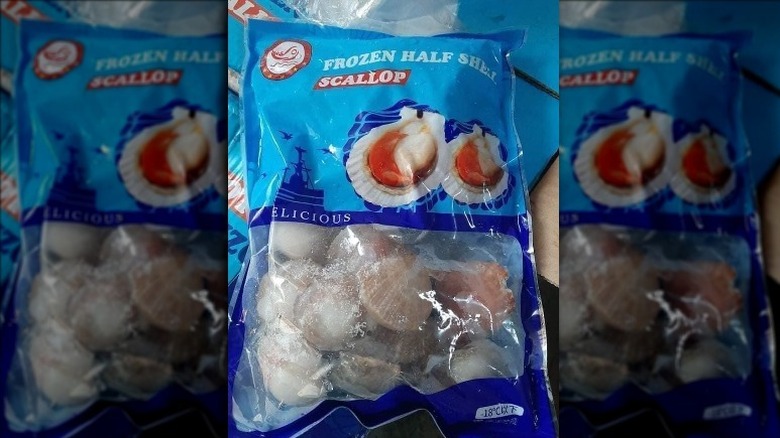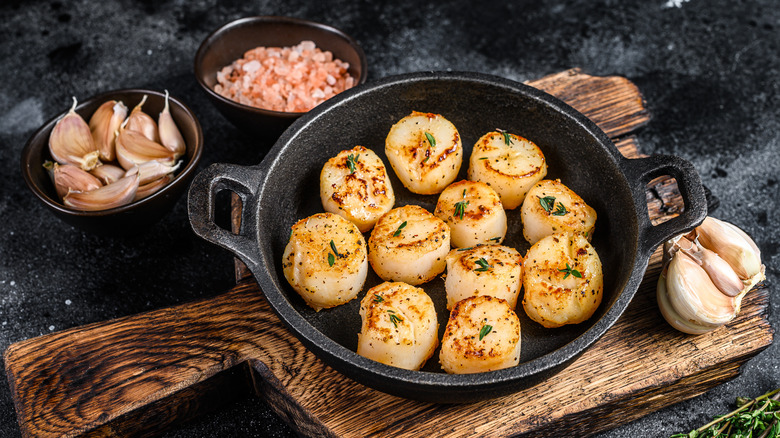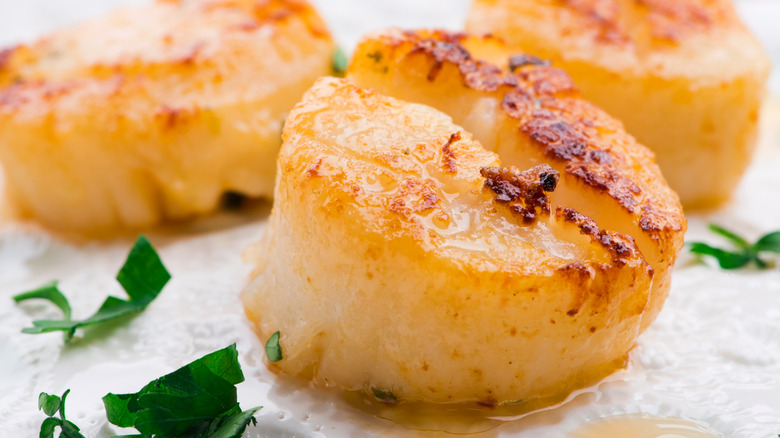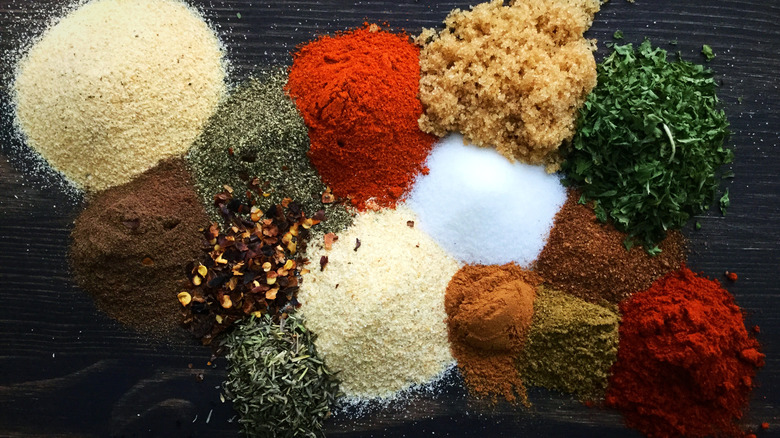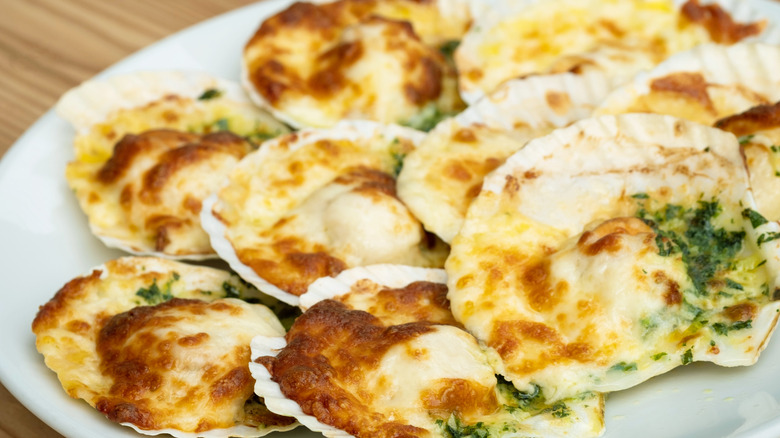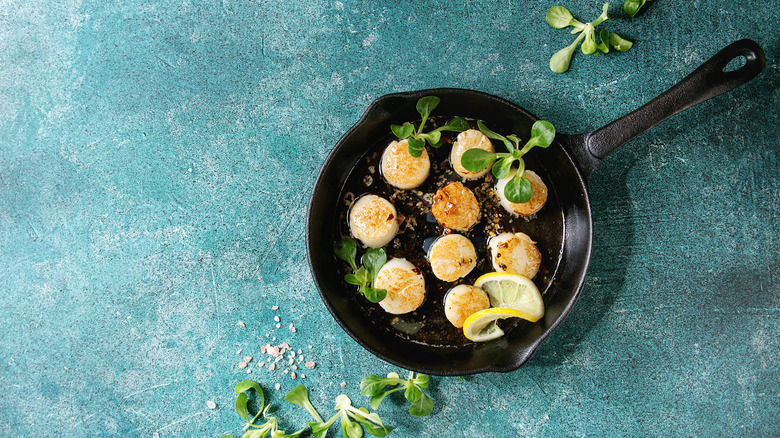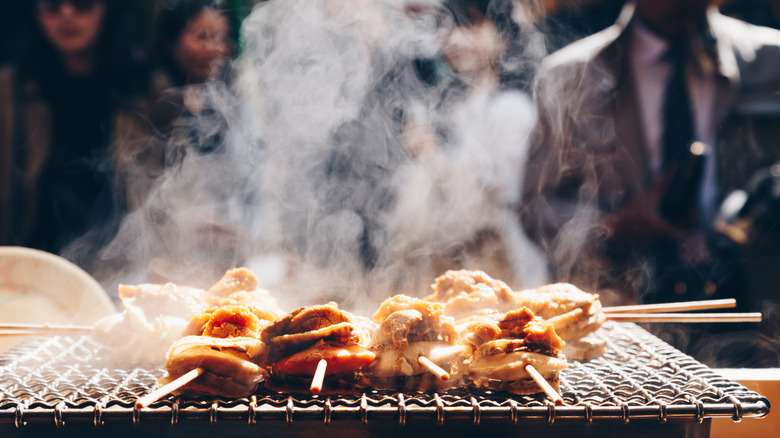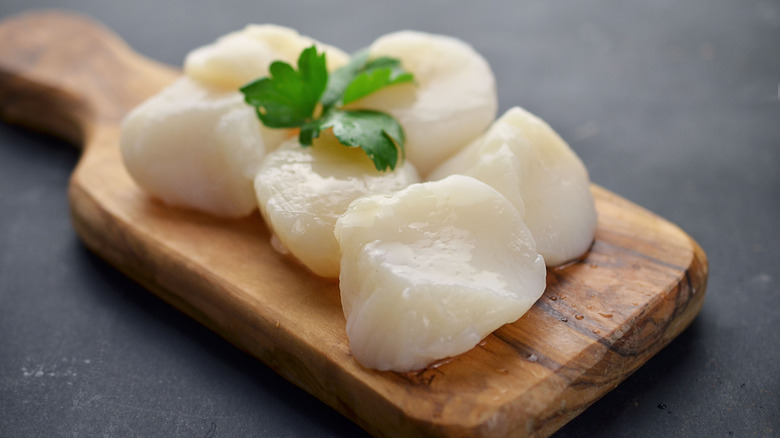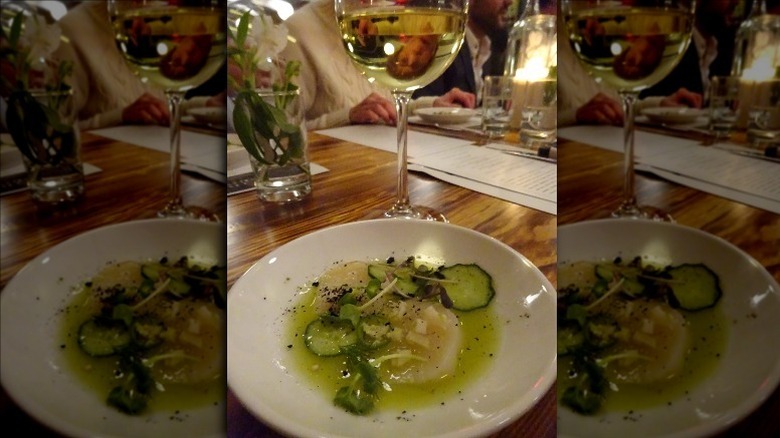Mistakes Everyone Makes When Cooking Scallops
If you've ever eaten scallops at a top-notch seafood restaurant, then you know just how delicious they can be. They have a light, delicate flavor to them that's somehow both fishy and not fishy at the same time. Their texture is smooth and silky, even more so than the flesh of their other bivalve cousins. Whether you get them in a soup, on top of a pasta dish, or by themselves, they never fail to impress — if they've been cooked well.
Go to a spot that doesn't serve great scallops or try to make them yourself without the proper know-how, and you're in for an entirely different experience. A poorly cooked scallop might be chewy, mushy, or totally flavorless. It could taste like getting a mouthful of dirty seawater or biting into rubber. And clearly, that's something you'll want to avoid in your own kitchen — especially if you plan on serving your scallops to guests.
So, before you pick up any scallops from your local seafood counter, you're going to want to make sure you know how to prepare them properly. That's why we've outlined some of the most common scallop mistakes below. Avoid making these slip-ups, and you're sure to whip up some of the best scallops you've ever tasted.
Buying 'wet' scallops
Here's the unfortunate truth: It can be difficult to find the right scallops when you go to the market. That's because many scallops out there have been treated with a chemical called sodium tripolyphosphate (STP), according to Serious Eats. These scallops are often referred to as "wet" scallops because the chemical allows them to soak up a ton of water. Clearly, this isn't ideal when it comes to scallops you intend to sear, as too much moisture could prevent you from getting a nice, golden-brown crust. Additionally, it can also add a soapy, unpleasant taste to your scallops. Since scallops have such a mild flavor anyway, that foul flavor addition can be quite intrusive.
Therefore, you're going to want to avoid these treated "wet" scallops when you go shopping. They may be more common — and they're almost guaranteed to be cheaper than the unadulterated alternative — but they're going to be incredibly difficult to cook properly. Rather, you're better off forking out a bit more cash so you can get "dry," unprocessed scallops. They will sear much more reliably, and they're going to taste way fresher and just more delicious in general.
Forgetting to further dry your scallops before cooking
If you've spent much time over the stove searing various meats, then you know that it's not always the easiest task. There are a few different factors that need to come together in order to really achieve that proper browned exterior. Perhaps the most significant factor? You can't have too much moisture in the pan, and that's not an exception when it comes to cooking scallops. If you're having a problem searing scallops well, there's an excellent chance it's because they're too wet.
Of course, you should avoid buying scallops treated with STP, but that may not be enough to ensure the perfect sear. In addition to buying dry scallops, make sure you further dry them before throwing them into a pan, according to Quartz. First, you should throw them on a bed of paper towels to immediately soak up that extra moisture. Then, throw some salt on them and wait for about 15 minutes. Dry them off again, get your pan ready, and then throw them on.
While this extra step may seem fussy and unnecessary, we guarantee that it's going to make a significant difference when you finally dig into your scallops. Taking that extra bit of time is well worth it in this case.
Buying previously frozen scallops
Not only should you think about whether you're buying wet or dry scallops, but you also want to make sure that you're buying fresh scallops if at all possible, according to The Spruce Eats. Fresh scallops tend to have a better flavor, and since they're already so light-tasting, it can make a significant difference. If you live on the East Coast or are in another region close to a source of scallops, and you have a reliably good seafood market, you're absolutely in luck. That's exactly where you should go find your top-quality scallops, and you should cook them ASAP to make sure they're as fresh as possible when you eat them.
However, that doesn't mean you should disregard frozen scallops in every case. If you don't live anywhere near the coast, you may be better off buying individually quick-frozen scallops instead of the fresh ones that have been sitting out for a few days at your grocery store's seafood counter. If you do buy frozen scallops, make sure you place them in the refrigerator overnight before you cook them — you don't want to defrost your scallops at room temperature.
Using regular butter to sear your scallops
We all love cooking our favorite foods in butter. It's creamy and rich and adds a delicious flavor to your food that you can't get from cooking oil alone. However, as much as you may want to sear your scallops in butter, it's generally not the best idea. That's because, according to Serious Eats, the solids in the milk will burn when you place them on the high heat that is needed to properly sear a scallop. This can cause a burnt taste, and it might even leave little flecks of black over your otherwise-perfect scallops.
Instead of using butter, you're better off opting for an oil with a high smoke point, like vegetable or canola oil. These oils will allow you to get your pan nice and hot without an issue. Once the oil starts to smoke slightly, you can throw your scallops on. However, if you're intent on using butter, you do have options. Ghee or clarified butter are excellent options for searing since they are free of milk solids.
Overcooking your scallops
As with many types of seafood, one of the most egregious errors you can make is overcooking your scallops. Since scallops are incredibly light and delicate (not to mention quite small), they're easy to overcook. And as some beginner cooks are squeamish when it comes to working with seafood, it makes sense that you'd want to carefully ensure that you're killing any bad-for-you bacteria. However, if you leave your scallops on the stove for too long, you're almost guaranteed to get a rubbery mess for dinner.
There's not one specific amount of time you should cook your scallops to ensure they come out perfectly, as that will largely depend on the size of your scallops. However, Savory Experiments asserts that even the largest scallops shouldn't take any longer than two minutes per side, as long as you have the burner on high.
The best way to tell if your scallop is cooked to perfection? Keep an eye out for a nice crust to form. When it forms on one side, it's time to turn your scallop over. When the same thing happens to the other side, it's done. Don't leave it to sear for longer than that, or you're likely to overcook it.
Using powdered spices while cooking your scallops
In most cases, you'll want to season your protein before you start cooking it. There are some exceptions, but scallops are not one of them. However, you'll want to make sure that you're careful with what kinds of seasonings you're applying to your scallops. Of course, you'll want to hit them with some salt and pepper before they go into the pan. Not only does salt help draw the moisture out, but it's also going to give you just enough flavor to take your scallops from bland to melt-in-your-mouth delicious. Pepper adds even more dimension.
At this point, you can add other coarse seasonings as you please. However, you should be advised that powdered spices and seasonings aren't the best option here. Why? As CT Post notes, searing scallops covered in powdered seasonings results in a kind-of paste that will coat your seafood. This paste isn't too appetizing, and it doesn't even adequately season your scallops. If you want to add in extra flavors with powdered seasonings, just make sure you do that after you take the scallops off the heat.
Combining them with super-strong sauces or flavors
There are about a million different scallop recipes, many of them absolutely delicious. And cultures around the globe all have their own different ways of preparing scallops. However, in many cases, you're going to want to stick with lighter flavors when you're cooking with scallops (via Eating Well). Since they are so light and delicate themselves, scallops can easily be overwhelmed by more powerful flavors. Therefore, a simple preparation is often the best route to take.
Scallops pair well with spring vegetables like peas, which have a similarly delicate taste to them. They're also fantastic in butter and cream sauces. We love to eat our scallops with pasta in a buttery sauce, but they're amazing prepared in a variety of different fashions.
Of course, sometimes, scallops can mix and mingle with more powerful flavors to great effect, though. Just think of a spicy seafood soup that features scallops. The broth is often quite intense, and the milder scallops can really soak up all that flavor. So, follow whatever recipe you have, but if you're preparing your scallops on a whim, you should probably not cover them in a sticky BBQ sauce — just our take.
Moving the pan around once your scallops start to cook
You know how with some dishes, you can throw them around and give them a little wiggle from time to time to ensure that nothing is burning and everything in the pan is cooking evenly? It may look like an impressive move when you're cooking for someone, but when it comes to scallops, this is not advisable. According to CT Post, after you throw them in the pan, you should just let them be. This will allow them to form that nice crust you're looking for.
You may be wondering how you can even tell when they're ready to be flipped. You're not going to want to keep lifting them up and checking them, after all. Instead, you should just keep a close eye on the bottom edge of the scallop. When it starts to turn brown and crispy, you're going to hold off even more — probably for about 20 seconds. Then, you can finally flip your scallop. It can be difficult to be patient during this part of the process, but luckily, scallops do cook relatively quickly.
Assuming that you should only sear your scallops
While most of the mistakes we've outlined here relate to searing your scallops, you may be excited to know that that's not the only way to cook them. Searing is a go-to option for cooking scallops because it's easy and accessible, and it comes together in no time at all. And who doesn't love that crispy crust that forms with a nice sear? But if that's the only way you've ever had your scallops before, you may want to try something different.
If you have a grill available, spark it up and cook your scallops over the fire. The smokiness will add a lovely touch of flavor, and you can't beat the look of grill marks on your scallops. This is a solid idea for a summertime cookout if you want to offer something a little out of the ordinary in place of your typical hot dogs and hamburgers.
It's also possible to steam your scallops. While this preparation may not be as flavorful as others, it's easy to pull off and makes it simple to whip up a healthy seafood meal to share with your family.
Moral of the story? Don't be afraid to try new cooking techniques with your scallops! You may just be surprised at the delicious, unique dishes you can throw together when you think outside the box.
Not checking to see how translucent they are
While you can eat your scallops raw (as you'll see later), many people are going to want to make sure that they're cooked all the way through before they dig in. This is especially important if you didn't select your scallops specifically to eat raw. But since scallops tend to cook so fast, especially when you're searing them, it can be difficult to know if you've cooked them all the way through or not until you actually take a bite. So, what should you be looking for? Instead of pulling our your trusty meat thermometer, you're better off just taking a good look at the scallop.
What you're looking for is for the protein to grow opaque. You know how when you see a raw scallop, it's kind of translucent? Well, cooking meats tends to turn the flesh more opaque, according to Reluctant Gourmet, and scallops are no exception. As they cook, you can watch them turn from translucent to that pretty opaque color you're used to seeing when you order scallops from a restaurant. This should give you a good indication of whether your scallops have been cooked long enough.
When they do turn opaque, take them off the heat right away and dig in.
Cooking them at all
Of course, these are all mistakes you should avoid when you're cooking scallops ... but who ever said you need to cook them in the first place? No, we don't mean that you should just dump them in the trash because you can't figure out how to prepare them. Rather, if you have reliably sourced fresh scallops, you should consider keeping them raw and making them into a special dish.
Raw, you ask? Isn't that dangerous? While eating raw seafood can pose a risk, it's generally safe to eat raw scallops, according to Food52. And not only can you eat scallops raw, but you totally should — they're delicious that way. Scallops always have a lightly sweet flavor to them, but that incredible taste is so much more pronounced in a raw scallop than it is in a cooked one. Just keep in mind, though, that you're not going to want to do this with just any random scallop. Rather, you're going to want to go to a trustworthy seafood spot and know what you're looking for before you go. Don't be afraid to ask questions once you get there.
Once you have the scallops on hand, you may be wondering what to make with them if you leave them raw. We think a scallop aguachile is a fantastic place to start if you want to make something that's surely going to impress.
